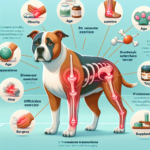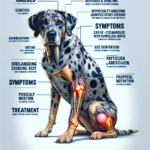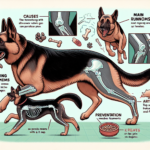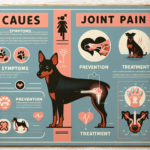Schipperke Joint Pain: Causes, Symptoms, Prevention, and Treatment
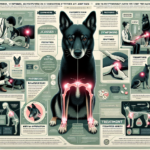
Introduction
The Schipperke, often referred to as the “little black devil,” is a small, robust breed known for its lively and curious nature. Originating from Belgium, the Schipperke was initially bred to serve as a watchdog and vermin hunter on barges and in households. This breed is characterized by its fox-like face, dense black coat, and a distinctive ruff of fur around its neck. Schipperkes are highly intelligent, energetic, and loyal, making them excellent companions for active families.
While Schipperkes are generally healthy dogs, they are not immune to certain health issues. Common concerns include eye problems, hypothyroidism, and joint-related issues. Joint pain, in particular, can significantly impact a Schipperke’s quality of life, making it essential for owners to be aware of the causes, symptoms, prevention, and treatment options available.
Maintaining joint health is crucial for Schipperkes due to their active nature and small size. Joint issues can lead to decreased mobility, pain, and a lower quality of life. Understanding the specific risks and management strategies for joint health in Schipperkes can help owners ensure their pets remain happy and active throughout their lives.
Breed-Specific Joint Pain Risks
Genetic Predisposition
Schipperkes, like many other breeds, have a genetic predisposition to certain joint-related issues. Hip dysplasia, a condition where the hip joint does not fit properly into the hip socket, is one such concern. Although more common in larger breeds, hip dysplasia can still affect Schipperkes. Additionally, patellar luxation, where the kneecap dislocates from its normal position, is another genetic issue that can cause joint pain in this breed.
Age-Related Risks
As Schipperkes age, they become more susceptible to joint pain and related conditions such as arthritis. Typically, signs of joint pain may start to appear in middle-aged to older dogs, around 7-10 years of age. However, early-onset arthritis can occur in younger dogs, especially if they have a genetic predisposition or have experienced joint injuries.
Activity Level and Joint Stress
Schipperkes are known for their high energy levels and love for physical activities. While regular exercise is essential for their overall health, excessive or inappropriate exercise can lead to joint stress and injuries. Activities that involve jumping, sudden stops, or sharp turns can put additional strain on their joints, increasing the risk of joint pain and related issues.
Common Symptoms of Joint Pain in Schipperkes
General Symptoms
- Limping or favoring one leg
- Stiffness, especially after rest or exercise
- Reluctance to move, jump, or climb stairs
- Decreased activity or playfulness
- Swelling or heat around the joints
- Whining or showing signs of discomfort when touched
Breed-Specific Symptoms
In Schipperkes, joint pain may manifest as a reluctance to engage in their usual energetic activities. Owners may notice their Schipperke becoming less enthusiastic about playing, running, or jumping. Additionally, Schipperkes may exhibit changes in their gait, such as a “bunny hop” when running or an uneven stride.
When to Consult a Vet
If you observe any signs of joint pain in your Schipperke, it is essential to consult a veterinarian promptly. Early diagnosis and intervention can help manage the condition and prevent further deterioration. Seek veterinary advice if your dog shows persistent limping, stiffness, or reluctance to move, or if you notice any swelling or heat around the joints.
Preventive Measures for Joint Health
Exercise Recommendations
Regular, moderate exercise is crucial for maintaining joint health in Schipperkes. Activities such as walking, swimming, and gentle play can help keep their joints flexible and muscles strong. Avoid high-impact exercises like excessive jumping or running on hard surfaces, as these can increase the risk of joint injuries. Tailor the exercise routine to your Schipperke’s age, energy level, and physical condition.
Dietary Suggestions
A balanced diet rich in essential nutrients can support joint health in Schipperkes. Consider incorporating foods or supplements that contain glucosamine, chondroitin, and omega-3 fatty acids, as these can help maintain joint cartilage and reduce inflammation. Consult your veterinarian for specific dietary recommendations and appropriate supplements for your Schipperke.
Weight Management
Maintaining a healthy weight is vital for reducing joint stress in Schipperkes. Excess weight can put additional pressure on the joints, exacerbating pain and increasing the risk of joint-related issues. Monitor your dog’s weight regularly and adjust their diet and exercise routine as needed to keep them at an optimal weight.
Early Screening and Monitoring
Regular veterinary check-ups and early screening for joint issues can help catch problems before they become severe. Discuss with your veterinarian about breed-specific screening tests, such as X-rays or joint evaluations, to monitor your Schipperke’s joint health. Early detection allows for timely intervention and better management of joint conditions.
Treatment Options for Joint Pain
Non-Surgical Treatments
Non-surgical treatments for joint pain in Schipperkes include medications, physical therapy, and lifestyle adjustments. Anti-inflammatory drugs and pain relievers can help manage pain and reduce inflammation. Physical therapy, such as hydrotherapy or controlled exercises, can improve joint mobility and strengthen muscles. Lifestyle adjustments, such as providing a comfortable resting area and avoiding high-impact activities, can also alleviate joint pain.
Surgical Options
In severe cases of joint pain, surgical intervention may be necessary. Common surgical options for joint issues in Schipperkes include hip replacement, arthroscopy, and corrective surgeries for patellar luxation. These procedures can help restore joint function and reduce pain. Consult with a veterinary orthopedic specialist to determine the most appropriate surgical option for your dog.
Alternative Therapies
Alternative therapies such as acupuncture, massage, and laser therapy can provide additional relief for joint pain in Schipperkes. Acupuncture can help reduce pain and inflammation, while massage can improve blood circulation and muscle relaxation. Laser therapy uses light energy to promote healing and reduce pain. These therapies can be used in conjunction with conventional treatments for a holistic approach to joint pain management.
Lifestyle and Management Tips
Daily Care Routine
Establishing a daily care routine can help manage and alleviate joint pain in Schipperkes. Include gentle exercises, such as short walks or swimming, to keep their joints flexible. Provide a comfortable resting area with orthopedic beds to support their joints. Regularly monitor their weight and adjust their diet as needed to maintain a healthy weight.
Modifying the Home Environment
Making adjustments to your home environment can make it more comfortable for a Schipperke suffering from joint pain. Use ramps or steps to help them access furniture or climb stairs without jumping. Provide non-slip mats to prevent slipping on hard floors. Ensure their resting area is easily accessible and free from drafts.
Long-Term Management
Long-term management of joint pain in Schipperkes involves regular veterinary check-ups, ongoing monitoring of their condition, and maintaining a consistent care routine. Continue with appropriate exercises, a balanced diet, and weight management to support their joint health. Stay informed about new treatments and therapies that may benefit your dog.
FAQs About Schipperkes and Joint Pain
What are the early signs of joint pain in Schipperkes?
Early signs of joint pain in Schipperkes include limping, stiffness, reluctance to move, and decreased activity levels. You may also notice swelling or heat around the joints and changes in their gait.
Can joint pain in Schipperkes be prevented?
While genetic predispositions cannot be entirely prevented, you can take measures to reduce the risk of joint pain in Schipperkes. Regular exercise, a balanced diet, weight management, and early screening can help maintain joint health and catch issues early.
Are there specific exercises that are better for Schipperkes with joint pain?
Low-impact exercises such as walking, swimming, and gentle play are better for Schipperkes with joint pain. Avoid high-impact activities like jumping or running on hard surfaces, as these can exacerbate joint issues.
What dietary supplements can help with joint health in Schipperkes?
Supplements containing glucosamine, chondroitin, and omega-3 fatty acids can support joint health in Schipperkes. These nutrients help maintain joint cartilage and reduce inflammation. Consult your veterinarian for specific supplement recommendations.
When should I consider surgical options for my Schipperke’s joint pain?
Surgical options should be considered when non-surgical treatments are no longer effective, and your Schipperke’s quality of life is significantly impacted by joint pain. Consult with a veterinary orthopedic specialist to determine the most appropriate surgical option for your dog.
Conclusion
Joint pain is a significant concern for Schipperkes, impacting their mobility and overall quality of life. By understanding the causes, symptoms, prevention, and treatment options for joint pain in this breed, owners can take proactive steps to ensure their pets remain healthy and active. Regular exercise, a balanced diet, weight management, and early screening are essential for maintaining joint health. If joint pain does occur, a combination of non-surgical treatments, surgical options, and alternative therapies can help manage the condition. Always consult with your veterinarian to develop a comprehensive care plan tailored to your Schipperke’s needs.
By staying informed and taking preventive measures, you can help your Schipperke enjoy a long, happy, and pain-free life.

